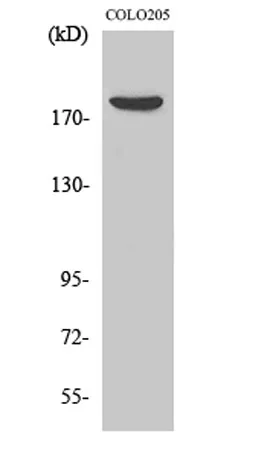MRCKβ rabbit pAb
CAT:
855-ES2818-01
Size:
50 μL
Price:
Ask
- Availability: 24/48H Stock Items & 2 to 6 Weeks non Stock Items.
- Dry Ice Shipment: No




MRCKβ rabbit pAb
- Description: This gene encodes a member of the serine/threonine protein kinase family. The encoded protein contains a Cdc42/Rac-binding p21 binding domain resembling that of PAK kinase. The kinase domain of this protein is most closely related to that of myotonic dystrophy kinase-related ROK. Studies of the similar gene in rat suggested that this kinase may act as a downstream effector of Cdc42 in cytoskeletal reorganization. [provided by RefSeq, Jul 2008],
- Synonyms: CDC42BPB; KIAA1124; Serine/threonine-protein kinase MRCK beta; CDC42-binding protein kinase beta; CDC42BP-beta; DMPK-like beta; Myotonic dystrophy kinase-related CDC42-binding kinase beta; MRCK beta; Myotonic dystrophy protein kinase-like b
- Gene ID: 9578
- UniProt: Q9Y5S2
- Cellular Locus: Cytoplasm. Cell membrane ; Peripheral membrane protein ; Cytoplasmic side. Cell junction. Cell projection, lamellipodium. Displays a dispersed punctate distribution and concentrates along the cell periphery, especially at the leading edge and cell-cell junction. This concentration is PH-domain dependent (By similarity). Detected at the leading edge of migrating cells. Localization at the leading edge of migrating cells requires interaction with catalytically active CDC42 (PubMed:21240187). Localizes in the lamellipodium in a FAM89B/LRAP25-dependent manner (By similarity)..
- Host: Rabbit
- Species Reactivity: Human, Mouse, Rat
- Immunogen: The antiserum was produced against synthesized peptide derived from human MRCKB. AA range:1641-1690
- Clonality: Polyclonal
- Validated Applications: WB, IHC, IF, ELISA
- Stability: 1 year
- Concentration: 1 mg/mL
- Dilution: Western Blot: 1/500 - 1/2000. Immunohistochemistry: 1/100 - 1/300. ELISA: 1/40000. Not yet tested in other applications.
- Molecular Weight: 194kD
- Storage Conditions: PBS with 0.02% sodium azide and 50% glycerol pH 7.4. Store at -20°C. Avoid repeated freeze-thaw cycles.
